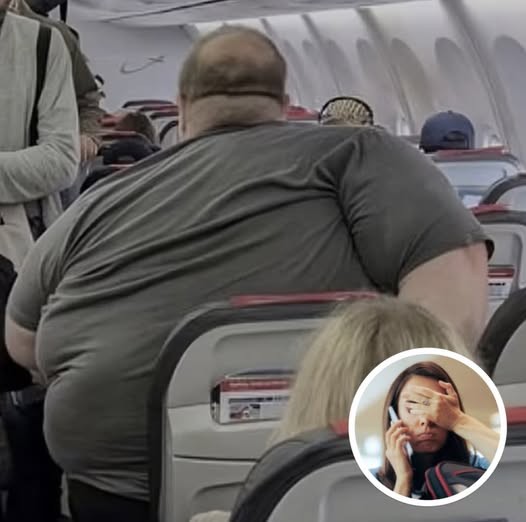A photo of a plus-size passenger struggling to fit into a standard airplane seat has reignited a heated national conversation about airline seating, accessibility, and who should bear the cost of inclusion.
The image, first circulated by consumer advocate Christopher Elliott and later amplified by Miami-based group Pretty Ricky, reportedly originated from a 2023 flight between Helsinki and Copenhagen. It shows the traveler attempting to settle into a narrow aisle seat, visibly constrained by the size of the seat itself. The post urged airlines to address the mismatch between shrinking seat dimensions and increasingly diverse body types, saying the current situation is unfair both to the passenger in question and to those sitting beside them.
The viral post drew thousands of reactions—some sympathetic, some combative. A vocal contingent argued that passengers who require more space should simply purchase an extra seat. “If you’re using two seats, you should be paying for two,” one commenter bluntly asserted, while another noted, “Tall passengers pay extra for legroom; why should width be treated differently?” A few even suggested weighing passengers prior to boarding, analogizing people to checked baggage—an idea many called dehumanizing, “inhumane,” and “disgusting.”
Others shifted the focus to airline policies themselves. Critics pointed out that over the years, carriers have progressively reduced seat width and pitch to squeeze more passengers aboard, squeezing comfort out of economy travel for almost everyone—not just larger-bodied flyers. Several voices pushed back against personal-blame narratives, highlighting systemic factors behind body size. “Many people take medications that induce weight gain,” one commenter noted. “Healthy food and fitness aren’t affordable or accessible to everyone. This isn’t always a matter of lifestyle choice—so the burden shouldn’t rest solely on the individual.”
Into the swirling debate stepped plus-size travel influencer Jaelynn Chaney, 28, of Washington state, known for her advocacy around fat liberation and inclusive travel. Chaney responded directly to critics in a TikTok video, rejecting the notion that she—or people like her—should alter themselves or be sidelined to avoid inconvenience. “I’m not luggage,” she declared, addressing proposals that she be charged based on body weight. “Telling me to lose weight or buy a first-class ticket misses the point. The problem isn’t me. It’s the system.”
She went on to explain that even premium cabins often fail to accommodate her frame comfortably, underscoring her argument that solutions must be structural rather than individual. “Why should I have to shrink myself to fit into spaces never designed for me?” she asked, framing the issue as one of design and equity rather than personal deficiency.
When critics suggested that she simply avoid flying if it’s uncomfortable, Chaney pushed back again. “Flying is not a luxury for everyone,” she said. “People travel for work, emergencies, family obligations—life doesn’t pause because of your body type.” Her stance has since evolved into a broader policy campaign. Chaney is now advocating for federal action, including what she terms a “Fat Equality Bill of Rights,” aimed at ensuring air travel is fair and accessible across body sizes—calling for things like mandatory seat-size standards, optional free extra seating for passengers who need it, and better training for airline staff on dignity in service.
The online debate illustrates the tension between individual responsibility and systemic design. Some passengers and commentators see seat limitations as a personal logistics issue—buy another ticket, upgrade, or alter one’s body. Others argue that the industry engineered the problem by continually compressing cabin space while marketing air travel as universal. The picture of the struggling traveler became a flashpoint because it made visible what many uncomfortable flyers experience quietly: that current standards effectively exclude or burden people whose bodies don’t conform to a narrow “average.”
Airlines have responded inconsistently to such pressure points in the past, offering occasional “extra seat” policies with varying terms, and sometimes recommending that larger passengers book two seats for comfort—often without clarifying refund or rebooking procedures, which leaves many feeling stigmatized or financially penalized. Disability advocates and inclusion experts say framing the solution solely around ticket sales or punitive measures misses opportunities for redesign: adjustable seating, wider aisles, and clearer communication could reduce conflict while serving a broader passenger base.
As the conversation continues online and in industry circles, a central question remains unresolved: should travelers be expected to adapt—paying more, changing their bodies, or self-excluding—or should airlines evolve their product to reflect the full spectrum of human diversity? The viral image, though from a past flight, has reopened that debate in a sharper, more public way, with advocates like Chaney pushing to turn momentary outrage into lasting policy change.
